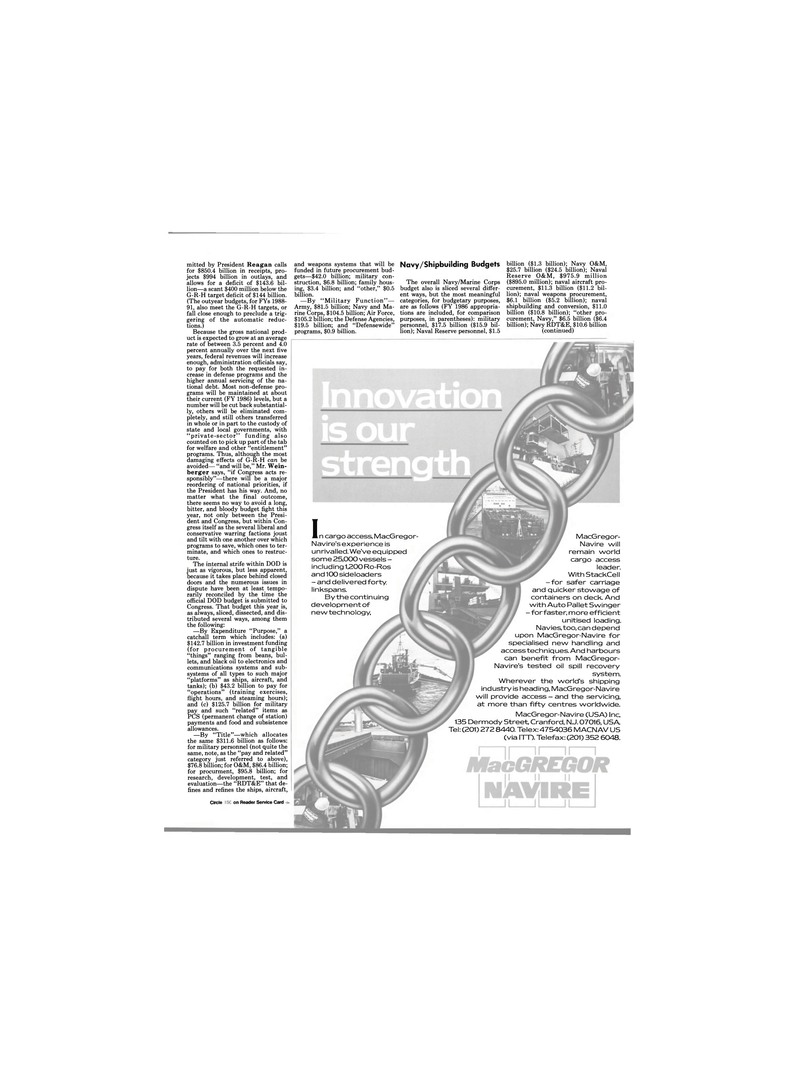
Page 23: of Maritime Reporter Magazine (March 1986)
Read this page in Pdf, Flash or Html5 edition of March 1986 Maritime Reporter Magazine
mitted by President Reagan calls for $850.4 billion in receipts, pro- jects $994 billion in outlays, and allows for a deficit of $143.6 bil- lion—a scant $400 million below the
G-R-H target deficit of $144 billion. (The outyear budgets, for FYs 1988- 91, also meet the G-R-H targets, or fall close enough to preclude a trig- gering of the automatic reduc- tions.)
Because the gross national prod- uct is expected to grow at an average rate of between 3.5 percent and 4.0 percent annually over the next five years, federal revenues will increase enough, administration officials say, to pay for both the requested in- crease in defense programs and the higher annual servicing of the na- tional debt. Most non-defense pro- grams will be maintained at about their current (FY 1986) levels, but a number will be cut back substantial- ly, others will be eliminated com- pletely, and still others transferred in whole or in part to the custody of state and local governments, with "private-sector" funding also counted on to pick up part of the tab for welfare and other "entitlement" programs. Thus, although the most damaging effects of G-R-H can be avoided— "and will be," Mr. Wein- berger says, "if Congress acts re- sponsibly"—there will be a major reordering of national priorities, if the President has his way. And, no matter what the final outcome, there seems no way to avoid a long, bitter, and bloody budget fight this year, not only between the Presi- dent and Congress, but within Con- gress itself as the several liberal and conservative warring factions joust and tilt with one another over which programs to save, which ones to ter- minate, and which ones to restruc- ture.
The internal strife within DOD is just as vigorous, but less apparent, because it takes place behind closed doors and the numerous issues in dispute have been at least tempo- rarily reconciled by the time the official DOD budget is submitted to
Congress. That budget this year is, as always, sliced, dissected, and dis- tributed several ways, among them the following: —By Expenditure "Purpose," a catchall term which includes: (a) $142.7 billion in investment funding (for procurement of tangible "things" ranging from beans, bul- lets, and black oil to electronics and communications systems and sub- systems of all types to such major "platforms" as ships, aircraft, and tanks); (b) $43.2 billion to pay for "operations" (training exercises, flight hours, and steaming hours); and (c) $125.7 billion for military pay and such "related" items as
PCS (permanent change of station) payments and food and subsistence allowances. —By "Title"—which allocates the same $311.6 billion as follows: for military personnel (not quite the same, note, as the "pay and related" category just referred to above), $76.8 billion; for O&M, $86.4 billion; for procurment, $95.8 billion; for research, development, test, and evaluation—the "RDT&E" that de- fines and refines the ships, aircraft,
Circle 282 on Reader Service Card and weapons systems that will be funded in future procurement bud- gets—$42.0 billion; military con- struction, $6.8 billion; family hous- ing, $3.4 billion; and "other," $0.5 billion. —By "Military Function"—
Army, $81.5 billion; Navy and Ma- rine Corps, $104.5 billion; Air Force, $105.2 billion; the Defense Agencies, $19.5 billion; and "Defensewide" programs, $0.9 billion.
Navy/Shipbuilding Budgets
The overall Navy/Marine Corps budget also is sliced several differ- ent ways, but the most meaningful categories, for budgetary purposes, are as follows (FY 1986 appropria- tions are included, for comparison purposes, in parentheses): military personnel, $17.5 billion ($15.9 bil- lion); Naval Reserve personnel, $1.5 billion ($1.3 billion); Navy O&M, $25.7 billion ($24.5 billion); Naval
Reserve O&M, $975.9 million ($895.0 million); naval aircraft pro- curement, $11.3 billion ($11.2 bil- lion); naval weapons procurement, $6.1 billion ($5.2 billion); naval shipbuilding and conversion, $11.0 billion ($10.8 billion); "other pro- curement, Navy," $6.5 billion ($6.4 billion); Navy RDT&E, $10.6 billion (continued) i n cargo access, MacGregor-
Navire's experience is unrivalled. We've equipped some 25,000 vessels - including 1,200 Ro-Ros and 100 sideloaders - and delivered forty linkspans.
By the continuing development of new technology,
MacGregor-
Navire will remain world cargo access leader.
With StackCell -for safer carriage and quicker stowage of containers on deck. And with Auto Pallet Swinger - for faster, more efficient unitised loading.
Navies, too, can depend upon MacGregor-Navire for specialised new handling and access techniques. And harbours can benefit from MacGregor-
Navire's tested oil spill recovery system.
Wherever the world's shipping industry is heading, MacGregor-Navire will provide access — and the servicing, at more than fifty centres worldwide.
MacGregor-Navire (USA) Inc, 135 Dermody Street Cranford, NJ. 07016, USA
Tel: (201) 272 8440. Telex: 4754036 MACNAV US (via ITT). Telefax: (201) 352 6048.

 22
22

 24
24
